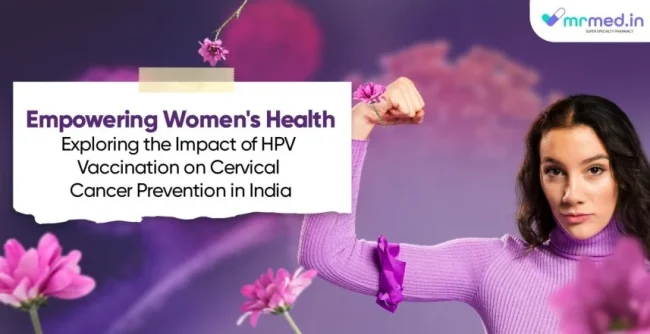
The truth behind the statistics: in India, cervical cancer claims the lives of countless women each year. Unfortunately, cervical cancer is the leading global malignancy in women, with a drastic increase in annual incidence rates. We are witnessing almost 99.7% of cases of cervical cancer that are caused by human papillomavirus (HPV). Most infections with HPV disappear spontaneously, but some persist as high-risk oncogenic types, which may cause cancers of the throat and anogenital area.
But, out of darkness, there is hope for the limelight – that is the HPV vaccine. For both men and women, vaccinating against HPV can help prevent them from getting cervical cancer. Currently, we have only three immunogenic prophylactic vaccines available for specific types of HPV that are cervical cancer. Now, we will reveal to you why it is important for everyone to we understand the role HPV vaccination plays in Indian women’s health storyline today.
Epidemiology
Everyone knows that cancer casts a dark shadow across the world, taking millions of lives each year. There are reports saying that about 8 million people die, and 14 million new cases of cervical cancer are presented annually. In developing countries like India, it is a harsh reality for many women that we are not aware of. It is reported that approximately 1 in 53 Indian women during their lifetime get cervical cancer compared with 1 in 100 women in more developed countries of the world, which is the worst scenerio. India carries a heavy burden, with a quarter of the world’s cervical cancer cases happening right here.
Why does cervical cancer hit countries like India so hard? What stops the help from reaching those who need it most? And most importantly, what can we do to change this story?
We are only left with these tough questions unanswered. Though these numbers and the sad stories are alarming, we have a chance for things to get better. These are cervical cancer vaccines that are developed by our researches around the world.
HPV Vaccines
HPV vaccines prevent cervical cancer by targeting specific viruses. FDA approves three types of HPV vaccines. Gardasil 9 protects against nine HPV types, preventing cancer and genital warts. Gardasil targets four types, reducing cancer risks. Cervarix also provides protection. In India, two common vaccines are used. Gardasil (Quadrivalent) guards against four types causing cancer and warts. Gardasil 9 (Nonvalent) shields against nine types. India launched Cervavac in January 2023, an affordable vaccine targeting prevalent HPV types.
Current Status of HPV Vaccination in India
Only in 2008, efforts to vaccinate teenage girls against HPV began in India with two types of vaccines. By 2018, a new vaccine was also licensed. Initially, vaccination programs in Andhra Pradesh and Gujarat showed promise but were temporarily halted due to reported deaths (which were later found to be unrelated to the vaccine). This pause resulted in some participants only getting one dose instead of the recommended two or three.
However, since 2016, successful vaccination drives in Punjab and Sikkim, along with government-supported efforts in Delhi, have shown high coverage and safety. There is also hope that even a single dose of the vaccine could offer strong protection.
In January 2023, the Indian Ministry of Health and Family Welfare wrote to seven state governments, spanning from Himachal Pradesh in the north to Tamil Nadu in the south, urging them to prepare for the roll-out of HPV vaccination for girls aged 9–14 years. This marks the first phase of India’s planned introduction of the HPV vaccine. Once these states have covered the targeted age group, HPV vaccination will become part of their routine immunisation programs. Similar efforts are planned for additional states and union territories in 2024 and 2025. Ultimately, it is estimated that 68 million girls in India will have been vaccinated against HPV. Subsequently, an additional 11.2 million girls aged 9 years will be targeted annually for routine HPV vaccination.
Points to Note:
Does HPV affect only women? HPV does not only affect women. we all know that HPV infections are more commonly associated with cervical cancer in womem. But what we are not aware of is that they are also common among sexually active men. In many cases that we see in men, HPV infections in men don’t show any kind of symptom. and they aslo tend to go away on their own as the immune system fights the infection. But ther are few persistent infections can lead to various types of cancer and warts.
Barriers to HPV Vaccination in India
Every efforts that were made to expand HPV vaccination in India, also faces several barriers:
1. Cost: Imported vaccines like Cervarix and Gardasil have been expensive. This makes them unaffordable for many. The new Indian-made Cervavac vaccine is expected to be more affordable, helping address this issue.
2. Stigma and Misconceptions: There is some kind of hesitation in India around discussing reproductive health topics, including cervical cancer. There are few Mistaken beliefs, like cancer being contagious or a death sentence. This hinder our open conversations and delay people from seeking medical care.
3. Cultural Beliefs: Some parents also worry that offering the HPV vaccine might encourage sexual activity in teenagers. This is a major misconception that are seen scattered. Lack of awareness about cervical cancer and its vaccine further fuels these fears and misconceptions, reducing vaccine acceptance.
4. Gender Bias: HPV vaccination every efforts have mainly focused on women, overlooking the fact that HPV can also cause cancer in men. Lack of awareness has led to this oversight.
Overcoming All These Barriers
To scale up HPV vaccine implementation in India, we need to focus few things. These are public education about HPV and the vaccine, reduce vaccine costs, improve access, and encourage strong physician endorsements. Government initiatives like endorsements, tailored messaging, early vaccination promotion, community engagement, and data monitoring (making HPV cancer notable in hospitals) are also essential. We should keep these factors in mind with simple steps forward— we can effectively increase HPV vaccine uptake. This would help us reduce cervical cancer rates, and improve women’s health outcomes nationwide.
Conclusion
One of the key ways to prevent cervical cancer is by receiving the HPV vaccine and create awareness of the same. We also should get some regular screening tests. We should also seek medical advice if abnormalities are detected. These HPV vaccine has the potential to significantly decrease the number of cervical cancer cases in India. But, overcoming these barriers and also preventing individuals from getting vaccinated is important. All our stakeholders, including government and community members, to prioritize women’s health. Together, we can ensure that every woman in India has the opportunity to receive life-saving HPV vaccination and promote a healthier future.
Stay Connect Our website Get News 360
